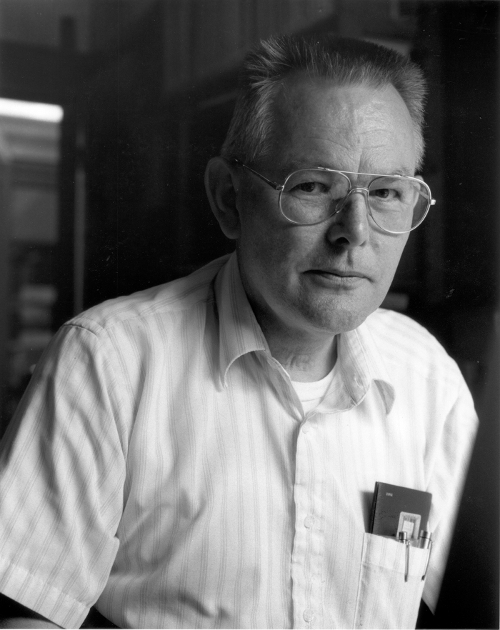 Ernst Raimond, 1994. (Photo courtesy of Seth Shostak)
Ernst Raimond, 1994. (Photo courtesy of Seth Shostak)
Ernst Raimond
Contributed by Jan Noordam
Ernst Raimond was born in 1932 and died in 2010.
Ernst belonged to the first generation of radio astronomers in the Netherlands. They started their career with the 7.5m Wurzburg antenna in Kootwijk, and continued with the huge (25m) new Dwingeloo telescope after 1956.
After his PhD in Leiden, and two years at Caltech, he joined the group at SRZM (now ASTRON) that was again planning the largest radio telescope in the world. Originally, this was to be the Benelux Cross Antenna, for which he extensively scouted the border area with Belgium. When it was decided to build an aperture synthesis telescope in Drenthe instead, he directed the development of the on-line control system and participated in the programming. After the opening of the WSRT in 1970, he became its first director In 1975, he spent a year in the USA to lend his knowledge and experience to the building of the VLA.
In the early eighties, he led the Dutch contribution to the data reduction software for the IRAS infrared satellite, which required many trips to the USA. Together with Friso Olnon, he published the IRAS SWS catalog in 1985, which attracted a good deal of interest.
He served his turn as chairman of the 'Werkgroep', i.e. as de facto Director in Dwingeloo. But his main role was as head of the Computer Group. As a boss, he was of the academic type. Altough this did not lead to crisp focus and sacred timelines, it did create the conditions that (somehow) led to the strong international position of ATRON today.
Ernst was closely involved in the UK-Dutch-Spanish-Canadian collaboration to build large optical and mm-wave telescopes on La Palma and Hawaii. Together with Ger van Diepen he developed a large-scale system for the archiving of the observations made at these two observatories.
Ernst was seconded for two years to the International Astronomical Union (IAU), to prepare its General Assembly in The Hague in 1996.
![[IAU logo]](iau_wb_thumb.jpg)
![[URSI logo]](URSI-logo-thumb.jpg)
![[Karl Jansky at his antenna]](jansky_photo_02_thumb.jpg)
![[Reber's Wheaton antenna]](Reber_Telescope_Wheaton_thumb.jpg)
![[Dover Heights]](Dover_Heights_02_thumb.jpg)
![[4C telescope]](GB61-195_4C_telescope_thumb.jpg)
![[Ewen and horn antenna]](ewen_horn1s.jpg)
![[Dwingeloo, 1956]](Dwingeloo-1956-thumb.jpg)
![[Jocelyn Bell Burnell and Cambridge antenna used in pulsar discovery]](burnell2_thumb.jpg)
![[Lovell Telescope at Jodrell Bank]](site_1594_0001-500-334-20180316163019-thumb150.jpg)
![[Wilson, Penzias, and Bell Labs horn antenna]](wilson-penzias-horn_thumb.jpg)
![[6-m Millimeter Radio Telescope in Mitaka, Japan]](6m-thumb.jpg)

